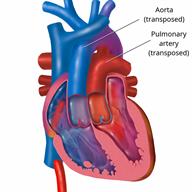Arteries in the Heart That Are Reversed (Transposition of the Great Arteries) in Infants: What to Know

Transposition of the great arteries is a heart defect that a baby is born with. It is also called a congenital heart defect. If your baby has this condition, the two arteries that lead away from his or her heart (aorta and pulmonary artery) are in a reversed position (transposed). This may also be called dextro-transposition of the great arteries (d-TGA).
A baby with this condition will have surgery as an infant to repair the defect. Babies who have surgery for this defect may be at greater risk for certain problems later in life, such as problems with the heart rhythm or with heart pumping. Your baby will need to see a heart specialist regularly so that his or her condition can be monitored.
What are the causes?
The exact cause of this condition is not known.
What increases the risk?
The following factors may make a baby more likely to have this condition:- Genetic or chromosomal factors, such as being born with Down syndrome.
- Being born to a mother who is over the age of 40 at the time of pregnancy.
- Being born to a mother who had the following during pregnancy:
- Uncontrolled diabetes.
- Certain viral illness.
- Use of alcohol or tobacco products.
- Poor nutrition.
What are the signs or symptoms?
Symptoms of this condition include:- Blue lips or skin.
- Skin that is cool, pale, and moist.
- Rapid breathing.
- Difficulty breathing.
- Rapid heartbeat.
- Difficulty feeding.
- Poor weight gain.
Symptoms may be present at birth. In some cases, they may not show up for several days.
How is this diagnosed?
This condition may be diagnosed based on:- Your baby's symptoms and a physical exam. The health care provider will listen to your baby's heart for unusual sounds.
- Various tests, such as:
- Blood tests.
- Imaging tests. These may include chest X-rays, an ultrasound of the heart (echocardiogram), a CT scan, or an MRI.
- Electrocardiogram (ECG) to measure the electrical activity of the heart.
- Cardiac catheterization. This is a procedure in which a small, thin tube (catheter) is passed into a blood vessel near the heart and used to test blood movement and heart function.
This condition may be diagnosed before birth during a prenatal ultrasound.
How is this treated?
This condition is treated with surgery to put the arteries back in their correct positions or by creating a tunnel between the atria of the heart. Surgery is usually done within a week or two after the baby is born. Before surgery, your baby may need supportive care, such as:- Use of a machine to help the baby breathe (ventilator).
- Food and fluids given through an IV.
- Medicine that helps to keep blood vessels open.
- A procedure to create or increase the size of an opening in the wall between the two sides of the heart (balloon atrial septostomy). This lets the blood mix more until surgery can be done.
- Surgery to move the arteries back to their correct positions (arterial switch procedure).
- Surgery that creates a tunnel (baffle)between the atria. This redirects oxygen-rich blood to the aorta and right ventricle.
Follow these instructions at home:
Follow instructions from your health care provider about how to care for your child at home.- Give over-the-counter and prescription medicines only as told by the health care provider.
- Follow instructions about caring for your child after surgery.
- Keep all follow-up visits. This is important.
Where to find support
-
American Academy of Pediatrics: www.healthychildren.org
-
The Children's Heart Foundation: www.childrensheartfoundation.org
-
National Center on Birth Defects and Developmental Disabilities: www.cdc.gov
Contact a health care provider if:
-
Your baby is not gaining weight as expected.
-
Your baby is feeding poorly.
-
Your baby is unusually tired or appears lethargic.
-
Your baby has a fever.
Get help right away if:
-
Your baby's lips, fingers, or skin turns blue.
-
Your baby's skin feels cool and clammy.
-
Your baby has difficulty breathing or is breathing very quickly.
-
Your baby's heart is beating very quickly.
-
Your baby who is younger than 3 months has a temperature of 100.4°F (38°C) or higher.
These symptoms may represent a serious problem that is an emergency. Do not wait to see if the symptoms will go away. Get medical help right away. Call your local emergency services (911 in the U.S.).
Summary
-
Transposition of the great arteries is a heart defect that a baby is born with.
-
If your baby has this condition, the two arteries that lead away from his or her heart (aorta and pulmonary artery) are in a reversed position (transposed).
-
This condition is treated with surgery. Surgery is usually done within a week or two after the baby is born.
-
It is important to keep all follow-up visits with your baby's health care team.
This information is not intended to replace advice given to you by your health care provider. Make sure you discuss any questions you have with your health care provider.

